|
Bearish conditions under Northern lights
AIH10 DXpedition to Aihkiniemi
October 15-29,
2011
By Mika
Mäkeläinen
The October
2011 DXpedition began with a unique challenge: the
coaxial cables needed to be fixed immediately because
a bear had broken three of them a few days earlier.
In addition, more antenna work was due. However,
it was a minor distraction because propagation conditions
remained below average. Still, we took full advantage
of openings to areas like Colombia, Panama, Mozambique,
Thailand and Southern China. We also logged Radio
Gambia, a station that has been on our most-wanted
list for the past couple of decades.
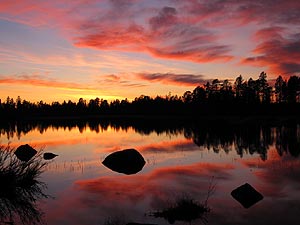
Sunset in Aihkiniemi (you
can click on the photos in this report to open
larger images in a new browser window) - Photo
by Jim Solatie |
Originally, I was supposed to
travel with Jim
Solatie to Lapland on Friday, October 14th.
But as usual, things don't always go as planned.
Jim needed to take care of his business in Helsinki
until Thursday, October 20th, after which he flew
to Ivalo.
So my lone journey north began on October 14th with
a car full of our stuff loaded on the overnight
train from Helsinki to Rovaniemi. I had the cabin
all to myself, and nobody else to blame for snoring.
After a relatively peaceful night, it was easy to
drive further north, despite a slight drizzle and
the ubiquitous reindeer wandering constantly across
the main highway.
Where's my reindeer burger?
I shopped for groceries at Lidl
in Sodankylä, which is the northernmost outlet
of the German chain store. Kitchen Joy's deep-frozen
Thai cubes — I could survive by eating just
panang curry chicken — were destined to keep
me alive for the duration of the DXpedition.

There goes my reindeer
burger |
Some things in Lapland never
seem to change, such as not being able to get a
decent hamburger above the Arctic Circle. Rovaniemi
— at the Arctic Circle — has the northernmost
McDonald's in the world, not that a Big Mac would
necessarily qualify as a decent burger. I tried
my luck in Saariselkä at what was supposed
to be a burger-oriented lunch restaurant. I said
I'd like to have a reindeer burger. "Why, we
don't have reindeer burgers" was the surprised
response. I pointed at the menu, prominently featuring
a reindeer burger. "Oh", was the response,
but we still don't have one. "OK, can I then
get a double burger?" The lady flipping burgers
admitted this was her first time preparing one,
and it seemed to take an eternity. No Michelin stars
awarded.
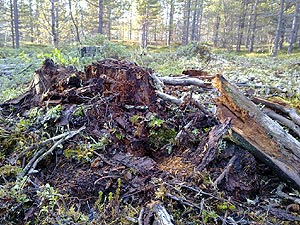
Tree stump ripped apart
by a bear, just 150 meters from our cabin |
Who ate my coax?
In Aihkiniemi, everything seemed
to be in order when I arrived early Saturday afternoon.
However, antennas pointing at 50° and 100°
were not working and measuring resistance indicated
that the coax feed cables were broken. In daylight
on Sunday, I discovered the problem. The cables
ran right next to a tree stump, which had been shattered
to pieces, presumably by a bear. Looking for worms
or larvae, the bear had accidentally cut two live
coax cables and one spare cable. Luckily, the weather
was very nice and there wasn't any snow yet, so
finding and fixing the cables was relatively easy.
Later, a review of the automated recordings left
to Aihkiniemi by Martti
Karimies and Jari Sinisalo revealed that the
uninvited prospector had paid a visit just a few
days earlier on October 11th. A local hunter told
me that most adult bears should be hibernating by
now, but cubs tend to stay awake longer. Sounds
very familiar.
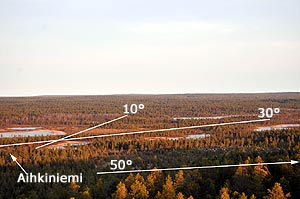
An aerial view of where
some of the antennas run |
During the DXpedition, we inspected
all 12 antennas, each close to 1 kilometer (3,000
ft.) in length. The latest addition to our arsenal
is a wire pointing at 46° that's meant to substitute
for the 50° antenna, which we had to take down
temporarily because of upcoming logging. During
the last two days of the DXpedition, we also had
to save the antennas pointing at 70° and 100°
from being chopped by forestry machinery. Overall,
the 100° wire was the most useful one because
conditions often favored South Asia.
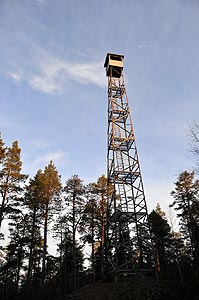
If you're not afraid of
heights, this open air watchtower on top of
Pyhävaara hill is located just 1.3 km from
our cabin and offers views all the way to Russia
and Norway. |
In some swampy areas, we lifted
the wires higher by erecting new support poles.
Other than that, there weren't many hardware chores
until the last evening, when the 46° wire suddenly
died. On the morning of our departure, when extracurricular
activity definitely was least needed, we managed
to find the point where the coax had been cut and
fixed it. This time the culprit was presumably a
reindeer or a moose.
Other wildlife encounters included spotting a fox
on the side of the road and reindeer roaming right
under our window. This was a peak year for lemmings
and, consequently, for owls. Cute and colorful Norway
lemmings (Lemmus lemmus) were spotted daily
in the forest, although getting one to pose for
my camera was far from easy. A Northern Hawk-Owl
(Surnia ulula) once landed on top of our
electrical pole to survey the surroundings.
Cold waters and warm showers
Weather-wise, the end of October
was unseasonably warm and, although we had below-freezing
temperatures for two days, there wasn't any snow
on the ground. By Sunday, October 23rd, our lake
had frozen, so crossing to the other side to check
antennas was a bit more challenging than usual.
At the Aihkiniemi Yacht Marina, we dedicated our
worn-out fiberglass rowboat to serve as an icebreaker.
The ice was still rather thin, and with brutal force
we reached the opposite shore less than 100 meters
away. A couple of days later, the lake was again
free of ice.

Cute lemmings are now
all over the forest |
Our austere cabin has a composting
toilet, but no running water. Instead of showering
in the cottages up north that we used a year earlier,
we tested another location just five kilometers
down the road. Matkapaikka
Jounila has well-equipped vacation units for
rent, and this being off-season, we were given a
key to one of the units to shower as often as we
wanted to for 10 euros per day. We paid an additional
10 euros each time we wanted to use the sauna.
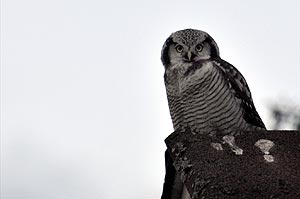
Northern Hawk-Owl (this
particular one was shot earlier in the summer
in Lemmenjoki, but the same species is prevalent
in Aihkiniemi as well) |
Propagation conditions were very
unstable, and on the first night I enjoyed the Northern
Lights, aurora borealis, which were visible
even behind a cloud cover. The Northern Lights were
seen on most nights during the first week, when
reception was generally better, but could not be
seen during the second week, despite a peak in the
A index. Go figure. Maybe the auroral oval had moved
further south.
During the first six days, U.S.
daytime conditions were occasionally decent and
favored the Pacific Northwest and Alaska, which
is typical for late October. Conditions to Asia
began relatively early in the afternoon and included
stations from Japan and other countries in the higher
latitudes. One of the highlights was Saturday, October
22th, when we had an excellent opening to Colombia
and Panama and a bit later to Cuba and the U.S.
East Coast. After that, propagation totally changed.
The Western Hemisphere offered mostly South American
stations, while South Asia was dominating the Eastern
Hemisphere. Only on the day of our departure did
conditions begin to improve again.
The following charts list solar
indices affecting propagation conditions during
the DXpedition. The first image aims to show how
some of the highlights coincided with exceptional
solar weather. As usual, thanks to Jan Alvestad
for compiling the figures.

| Date |
Mea-sured
solar
flux |
Sunspot
number |
Planetary
A index |
K
indices (3-hour intervals) |
Min-max
solar wind speed km/sec |
Number
of flares (events) |
ST
AR SDO |
NO
AA |
ST
AR |
NO
AA |
Daily
ap range |
Planetary |
Boulder |
C |
M |
X |
| 14.10.2011 |
136.1 |
268 |
157 |
2.3 |
2 |
0-6 |
00002111 |
00111110 |
334-407 |
7 |
. |
. |
| 15.10.2011 |
137.7 |
251 |
166 |
8.1 |
8 |
0-18 |
32012322 |
32102211 |
369-455 |
10 |
. |
. |
| 16.10.2011 |
151.0 |
237 |
158 |
7.0 |
7 |
2-12 |
23012222 |
23112222 |
404-443 |
9 |
. |
. |
| 17.10.2011 |
152.6 |
232 |
165 |
4.1 |
4 |
0-7 |
20001211 |
21001211 |
349-432 |
4 |
. |
. |
| 18.10.2011 |
146.8 |
214 |
144 |
4.9 |
5 |
0-7 |
22201211 |
22202210 |
345-382 |
3 |
. |
. |
| 19.10.2011 |
147.3 |
224 |
128 |
6.8 |
7 |
2-9 |
22022222 |
12022221 |
346-414 |
8 |
. |
. |
| 20.10.2011 |
159.1 |
314 |
161 |
4.6 |
5 |
0-7 |
21002222 |
21102221 |
354-413 |
2 |
1 |
. |
| 21.10.2011 |
167.8 |
278 |
184 |
4.6 |
5 |
2-7 |
22111121 |
13101221 |
298-412 |
3 |
1 |
. |
| 22.10.2011 |
164.1 |
279 |
164 |
2.8 |
3 |
0-5 |
10001111 |
11001100 |
275-359 |
3 |
1 |
. |
| 23.10.2011 |
155.5 |
223 |
102 |
3.1 |
3 |
0-6 |
00011121 |
01111211 |
270-343 |
4 |
. |
. |
| 24.10.2011 |
145.3 |
185 |
125 |
23.3 |
23 |
2-111 |
20200157 |
20211246 |
322-563 |
. |
. |
. |
| 25.10.2011 |
138.8 |
157 |
121 |
33.3 |
33 |
4-96 |
66533221 |
55643222 |
430-681 |
1 |
. |
. |
| 26.10.2011 |
132.2 |
142 |
91 |
3.1 |
3 |
2-5 |
10001111 |
21102211 |
363-527 |
1 |
. |
. |
| 27.10.2011 |
131.5 |
180 |
85 |
4.0 |
4 |
0-9 |
12211101 |
13212211 |
356-474 |
1 |
. |
. |
| 28.10.2011 |
133.9 |
171 |
91 |
2.1 |
2 |
0-5 |
00000111 |
00001010 |
278-435 |
3 |
. |
. |
| 29.10.2011 |
123.0 |
105 |
73 |
2.0 |
2 |
0-5 |
00000111 |
00001210 |
270-338 |
5 |
. |
. |
| 30.10.2011 |
126.7 |
163 |
80 |
5.5 |
6 |
0-15 |
10012312 |
01022422 |
269-419 |
8 |
. |
. |
In the following, I describe
the conditions in more detail. Our log will be published
much later because first we need to go through a
vast amount of recordings. To compare what was heard
elsewhere in the Arctic regions of Scandinavia at
the same time, check out parallel DXpedition reports
from LEM307
(Lemmenjoki, Finland), ENOX28
(Enontekiö, Finland), KONG21
(Kongsfjord, Norway), AND7
(Andøya, Norway) and PAX93
(Parkalompolo, Sweden).

The Aihkiniemi DX headquarters |
Saturday, October 15, 2011
I arrived in Aihkiniemi around
1:15 p.m. local time (1015 UTC), and immediately
rushed to check the conditions. It was easy, as
three Perseus receivers were already running, left
by Martti and Jari to record according to a pre-programmed
schedule. The AM band was quiet apart from a few
nearby stations in the Kola Peninsula in Russia.
A few Hawaiians and Alaskans were heard around 1300-1400
UTC, but nothing interesting. Asian stations emerged
around 1400 UTC, from all latitudes at the same
time, and likely including only the usual suspects.
KKXA
Snohomish WA on 1520 kHz
KKXA is licensed to Snohomish, which is
located near Seattle, Washington. KKXA
has a nighttime power of 50 kW, and the
antenna is beamed northwest, with a very
wide lobe, so no wonder that it can be
heard quite well also in Scandinavia,
which is NNE from Seattle. Here you can
listen to a sample KKXA
station ID recorded in Aihkiniemi.
Note that on the air the call letters
are abbreviated as "KXA". Email
your reception report to owner Andrew
Skotdal, andrew.skotdal (at) krko dot
com. Andrew still confirms reports with
a classic QSL card, which is a treasured
rarity in this era of email verifications.
"8th DX Report" was written
on the QSL card I received. Many thanks
Andrew! |
|
Sunday,
October 16, 2011
On Saturday evening North American
stations began to pop up as soon as the sun had
set, but conditions seemed to favor the regular
dominants from around the Great Lakes. Signal strength
improved steadily, and I started recording on two
different antennas before midnight UTC. Daybreak
offered some stations from Brazil and Argentina.
U.S. West Coast began to improve after 0400 UTC,
when I enjoyed listening to KKXA Snohomish, Washington,
on 1520 kHz, a brand new station playing country
music, and not just any kind of country, but the
best classic country! Nowadays I like my Coke Diet,
but my country still needs to be Classic.
I was hooked immediately. The Pacific Northwest
remained on the dial all the way until around 1330
UTC, which was very neat this early in the fall,
although signal strength was not earth-shattering.
During the daylight hours I was alerted by Kongsfjord
DXpeditionists to some Oceania stations, but I was
out fixing antennas at the crucial times. In the
afternoon, Asian stations appeared before 1300 UTC.
Initially the focus was in Japan, but later after
1500 UTC the Indian subcontinent was very strong.
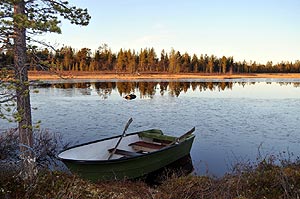
Ice forming in the Aihkiniemi Yacht Marina |
Monday, October 17, 2011
Trans-Atlantic conditions seemed
non-existent around midnight, and after admiring
fast-moving northern lights, I set Mestor software
to record a few top of the hour moments, and went
to bed. At daybreak there was an opening to Brazil
and Argentina. Also, isolated stations from Colombia,
Cuba, Atlantic Canada, the Midwest and the Pacific
Northwest were noted, but nothing spectacular. The
Monday morning listening session continued with
one very neat surprise: I heard WCPC Houston, Mississippi,
(940 kHz) for over an hour with a very strong signal.
It seems obvious that they continued on daytime
power through the night. CFCO Chatham, Ontario,
on 630 kHz was another welcome catch. This frequency
was recently vacated by local pest NRK, so it merits
extra scrutiny. Some Cuban stations continued until
around 0900 UTC, and again North American stations
were heard until around 1200 UTC, which was very
nice. Asian invasion began much earlier than usually,
already before 1200 UTC. Overall, Asian signals
were simply huge, and lasted long. Too bad that
there was hardly any focal point, as everything
from Japan to Iran was heard mixing happily throughout
the dial. Australians were heard later in the evening
on the X-band, so hopefully some will be found on
the regular AM band as well.
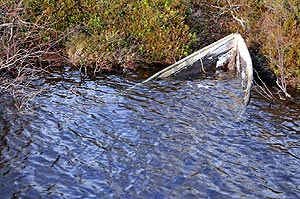
Oops, how do I explain
this to the other guys? |
Tuesday, October 18, 2011
Overnight conditions were very
poor to all of the Americas, based on a quick sample
of programmed recordings, and the morning rush hour
from around 0500 UTC, which I naturally monitored
live, was short-lived. Brazilians were stronger
than on previous mornings, so I'm hoping for some
new ones from there. The Western Hemisphere fell
silent after 0600 UTC, and there was a lull of six
hours before something interesting showed up. Daytime
hunt for Pacific stations was fruitless. Again,
it was Asians all over, but with emphasis on lower
latitudes, so I expect to find some new stations
for example from Thailand. In the afternoon, the
Pacific Northwest, Alaska and Hawaii returned for
a couple of hours (Hawaii on 1500 kHz heard as late
as 1600 UTC), but only the usual suspects.
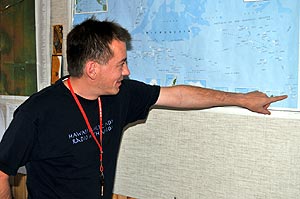
Here's Pohnpei, Micronesia,
home of Cross Radio (4755 kHz), caught on the
AIH10 DXpedition |
Wednesday, October 19, 2011
Overnight was again very poor
based on a brief peek of my automated recordings.
As European interference began to fade out around
0500 UTC, I expected Latin American stations, but
instead I got mostly Spanish stations that were
exceptionally strong. So were the British a bit
later, including stations such as BBC Three Counties
Radio on 630 kHz. The morning opening to North America
was relatively weak until around 0700 UTC, when
signals gained strength, and even graveyard channels
were audible. Lots of Mexican stations in the mix,
and mostly Bible Belt stations dominating. The Pacific
Northwest continued to be heard until around 1200
UTC, when it was already high time to switch to
another continent: Asia. The first Japanese stations
appeared already around 1100 UTC, but by 1200 UTC
the Chinese were on top. Alaskans and especially
Hawaiians were heard with impressive signals from
around 1000 UTC. As usual, a lot of East and South
Asian stations were heard in late afternoon, including
some Philippine stations in the mix. On Wednesday
evening a few North American stations appeared on
the dial already before their local sunset, but
they were all regulars, and I didn't notice any
daytime-only stations.
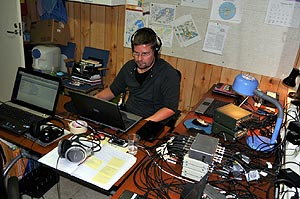
Jim reviewing recordings |
Thursday, October 20, 2011
Sunrise conditions favored Venezuela
and Colombia at 0500-0700 UTC, a first on this DXpedition.
At the same time, U.S. stations were quite weak,
but improved a bit after 0700 UTC, with a focus
in Midwest, then tapering off around 0800 UTC. Some
West Coast stations lingered on until around 1300
UTC. Asian stations made an initial appearance around
1200 UTC, but mostly disappeared by 1245 UTC. They
soon reappeared, but with a very southern focus,
for instance Pakistani stations were quite strong.
I left automated recordings to take care of South
Asia, and drove down to Ivalo to pick up Jim from
the airport.
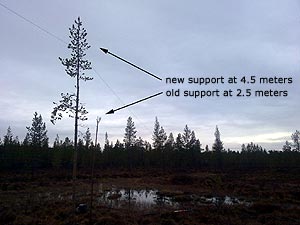
The antennas need to be
high enough to avoid moose and reindeer |
Friday, October 21, 2011
Lousy conditions can get even
lousier, as we discovered on Friday morning. After
a poor night there was bound to be at least the
sunrise effect bringing in trans-Atlantic stations,
or so we thought. There were a few Latinos and North
Americans, but that was it. The morning was the
worst of the week, with absolutely nothing of interest
to record around 0600 UTC, which should have been
prime time DX. Daytime conditions continued to be
poor, which allowed time for antenna work, but Radio
Kiribati on 1440 kHz was the surprise of the day.
Kiribati remained on the air hours beyond its regular
schedule due to local elections. Many thanks to
OJS and the rest of the KONG crew for the alert!
In the evening Asian stations leaned heavily south,
so in addition to All India Radio Thrissur on 630
kHz we should find several other interesting stations
from that direction. During the night U.S. conditions
leaned West after 2300 UTC, but unattended recordings
did the job while we were sleeping.
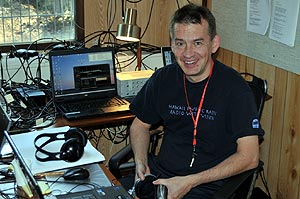
Mika is a public radio
guy, on and off duty |
Saturday, October 22, 2011
The morning began with fabulous
conditions to Colombia, Panama and the Caribbean
area, starting around 0500 UTC and weakening after
0700 UTC. This was definitely one of the best openings
to the area that I have ever been lucky to monitor.
There will be numerous new stations for both of
us on quite a few frequencies, including Radio Oxígeno
from Cúcuta, Colombia, on 980 kHz, in addition
to the dominant RCN Cali, and Radio Hogar from Panama
on 1250 kHz. Incidentally, we travelled to Colombia
the following month for vacation, so we had a chance
to get an ever closer look at the radio scene there.
Saturday morning continued with an excellent opening
to Cuba and the U.S. East Coast with catches such
as Radio Reloj, Bayamo (980 kHz) and WQNT Charleston,
South Carolina (1450 kHz). In the afternoon we finally
had decent conditions on shortwave, allowing us
to identify for instance Radio Fly from Papua New
Guinea (5960 kHz) and RRI Fak-Fak (4789.9 kHz).
However, when Asians began pouring in around 1200
UTC, Southern China was the northernmost area audible.
And no AM catches from the Pacific. ABC Busselton
WA (1152 kHz) did show up, for the first time on
this DXpedition, but counts more as an Indian Ocean
station, and seems to correlate with high solar
activity and disturbed conditions.
Sunday, October 23, 2011
Overnight was quite boring with
stations only from the Southern part of South America.
Even at daybreak, not a single trans-Atlantic signal
from above the Equator was heard, and hardly anything
of interest from further south. Again, what a difference
a day makes. Since Sunday morning was so lousy,
we decided to head out at 0700 UTC to check out
the condition of the remaining antennas. Daytime
was dead on the dial, due to continuous elevated
proton flux, and when Asian stations began emerging
around 1200 UTC, they were all from South Asia.
We had excellent reception of stations from Vietnam,
Thailand, Nepal and India, and have already identified
many rare Thai stations.

Jim's fusion cooking:
Finnish sausage and Thai chicken |
Monday, October 24, 2011
The protons continued to take
their toll, with a virtual radio blackout across
the Atlantic. No sign of the Caribbean, let alone
North America, and only stations from Brazil, Argentina
and the rest of southern South America were noted,
best around 0600-0700 UTC, after heavy European
interference subsided. Nothing was heard during
the daytime on Monday, so we checked and improved
the remaining antennas. In the afternoon the first
stations from South China and South Asia emerged
remarkably early, already around 1130 UTC. First
there were quite a lot of Thais, later Iranians,
but not much from further north, which was probably
due to the brewing geomagnetic storm. By the evening
signals weakened, and the AM band seemed empty aside
from some Europeans and a huge number of Middle
Eastern stations. Luckily later in the evening we
went after Africans, and managed to get half a dozen
stations from Mozambique, which is quite unusual.
Tuesday, October 25, 2011
The geomagnetic storm had hit
with full force, and the AM band was dead. Nothing
from across the Atlantic was heard overnight, and
not even at daybreak, so we continued sleeping,
and drove to stock up groceries in Inari later in
the day. In the afternoon South Asian stations began
to rise from the noise around 1400 UTC, but my initial
impression was that there was nothing special nor
any clear focus on any particular region. Some Thai
and Chinese stations appeared on the band late in
the evening, or morning in Asia, but otherwise nothing
to listen to, and no longer any signs of sub-Saharan
Africans.
Radio
Gambia on 648 kHz
Radio Gambia is a regular catch across
the Atlantic, but it has been very rare
in Finland. In 2007 it was logged by Ilpo
Parviainen in the morning, but this time
we caught Radio Gambia in the evening.
It was heard for a long period until sign-off
at midnight. I started looking for it
after I noticed that TWR Benin (1566 kHz)
was remarkably strong at its local sunset,
and it didn't take long before Gambia
emerged, at times on top of Radio Nacional
de España. A contributing factor
is that BBC fortunately no longer transmits
on the same frequency. Check out a clip
of the Radio
Gambia station ID in the Wolof language.
Bakary Jatta, Director of Radio Engineering,
kindly confirmed our reception reports. |
|
Wednesday, October 26, 2011
Automated overnight recordings
captured an opening to Brazil around 0000-0200 UTC,
weakening afterwards, but nothing from further north.
Daybreak resulted in a total meltdown on the AM
band. Europeans pretty much vanished around 0500
UTC, and the few remaining Argentine stations a
bit later, leaving behind a handful of Europeans
with ground wave propagation. This is certainly
not what the end of October should be, or at least
what it has been during the past few years. Asians
though were heard very early, the first stations
from Heilongjiang province in China appeared at
0950 UTC. Later on reception shifted, as usual,
to South Asia. In the evening we did have one excellent
surprise though, which saved the day: Radio Gambia
on 648 kHz, a station we both had been hunting already
for a couple of decades. Too bad that there are
nowadays very few AM stations left in Western Africa
outside Nigeria.

Pole dancing Lapland
style! Mika pushing a support pole deeper into
the swamp. |
Thursday, October 27, 2011
The Western Hemisphere was again
weak. In the afternoon, the first Asians were heard
already around 1200 UTC, but they receded an hour
later. A local Russian pest on 1521 kHz was off
the air during the day until 1300 UTC, a rare incident,
but conditions were too poor to catch anything new
there. Asian stations reappeared later in the afternoon,
but the familiar focus was South Asia. We would
have been lost without our 100-degree wire. In the
evening we hunted for African goodies, with some
nice results, including the second appearance of
Radio Gambia.
Friday, October 28, 2011
This morning offered the best
opening to Brazil and Argentina so far this fall.
Our catches included Radio 750 from Argentina and
Rádio Capital from Rio de Janeiro on 1030
kHz. Some other Latin American countries were also
represented, for example La Mexicana Radio from
Chile on 1330 kHz was booming. Today we had to dismantle
the remaining antennas to Asia, so we couldn't really
take advantage of the traditional afternoon opening.
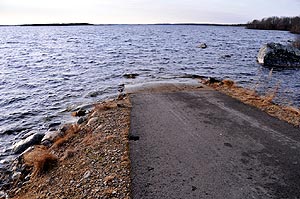
Whose job was it to read
the map! |
Saturday, October 29, 2011
As could be expected, conditions
would definitely improve on the day of our departure.
Due to housekeeping, packing, and last-minute antenna
chores, we had practically no time to spend listening
live, but morning conditions seemed to favor Ohio
and the surrounding areas. We left some automated
recordings to compensate for our poor timing, which
was very similar to the previous fall.
We left Aihkiniemi at 1:45 p.m.
local time, and drove down to Rovaniemi to catch
a train south. The night was an hour longer than
normally due to the end of the daylight savings
time, a very welcome remedy to cure our sleep deprivation.
However, I must say that nowadays on DXpeditions
we do get an almost adequate amount of sleep thanks
to sophisticated recording software that can monitor
the AM band for us overnights.
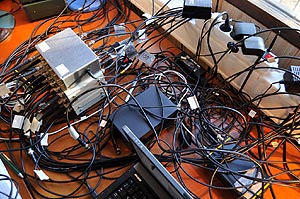
We're totally wired |
AIH10 was my first two-week-long
DXpedition in Aihkiniemi. It may sound like a long
time, but to a DXer, going there feels like entering
the Magic Kingdom — you just can't get enough
of it (although you can get more than enough of
recordings). We thoroughly enjoyed our time, and
endured each other's company quite well, even in
such close quarters. Time flies, and immersing into
the daily cycle of DXing is highly addictive. The
array of antennas in Aihkiniemi is so comprehensive
that no matter where the signals come from, you're
not left feeling underequipped. Propagation conditions
were not ideal, but as we are approaching the solar
maximum, this is probably the new normal.
Remember that Aihkiniemi is available
to you as well. You can read more about renting
Aihkiniemi for your DXpedition of a lifetime in
this article.
Published
on November 5, 2011 (slightly amended later)
  
|